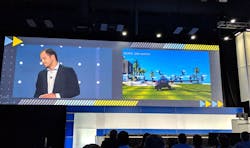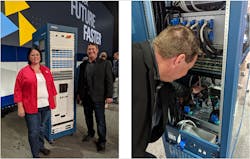NIWeek Showcase (Part 1): Flying Cars to Predictive Maintenance
Editor’s Note: This is Part 1 of a two-part series on the latest enabling technologies on display at NIWeek for applications ranging from flying cars to 5G. This part looks at personal air taxis and predictive maintenance. Part 2 looks at the state of autonomous vehicle test and 5G massive-MIMO antenna signal chain and power-amplifier design and test.
“The problem is that we are attempting to build systems that are beyond our ability to intellectually manage.” This quote by Nancy Leveson was used during a keynote at NIWeek, but summarized nicely the challenge that National Instruments (NI) spent a week showing engineers how to overcome.
From flying cars, autonomous vehicles, and 5G to prognostic asset health maintenance for high-speed trains and manufacturing, the many ways in which “time to insight” can be accelerated were envisioned, analyzed, and demonstrated.
The big NIWeek announcements from NI came early in the week and intimated that the event would be very much focused on getting design and test accomplished more quickly. In a pre-event briefing, Eric Starkloff, NI’s VP of global sales and marketing said that there is a need now to move away from the traditional “closed box” test equipment to a more open platform-based approach. This, he said, is the only way designers are going to address the complexity and customization requirements for test and measurement, particularly in an era of increasing hardware and software application development. From its standpoint, NI plans to accelerate this migration and help apply it throughout the whole product-development process.
To help make the point, the week’s keynotes gave cutting-edge examples of how customers used the NI tools to shorten development time and lower costs. Leap-frogging autonomous vehicles and jumping right the Jetson vision of flying cars, Santiago Morales, lead engineer at Joby Aviation, showed how his team was developing efficient safe and reliable flying transportation for everyday use, with the help of NI (Fig. 1).
1. Jody Aviation’s Santiago Morales showed clearly how NI’s FlexLogger saved the team as it worked on reliable flying transportation for everyday use. (Image source: ClariTek)
The four principal areas of research to enable the flying vehicle are (understandably): high-density batteries; high-torque electric motors; additive manufacturing; and light, composite materials. However, a priority during development was fast iteration. Morales told the story of having to tear down a motor overnight. Any design team can relate to this: the team was broken into two so that the work could be done in shifts, through the night.
“We found that a key feature of test is flexibility,” said Morales. “We need to be able to adapt on the fly and add functions,” among other things. In addition, they needed to be able to ensure measurements are being made in synch, so time-sensitive networking (TSN) was used to synchronize everything.
With LabVIEW, said Morales, the team was able to dispense with many of the mechanics of setting up timing and data acquisition. For example, “We used FlexLogger to add sensors without programming. We just added a strain gage to the wing, mapped it to a location, and started logging data in real time.”
It’s hard to deny the attraction of working with a team devoted to enabling flying cars, so for anyone interested in joining Jody Aviation, they’re currently looking for a whole crew of engineers, physicists, and technicians to join them.
Cummins Puts Engines in the Hardware Loop for Faster Test
Next to flying cars, there are few things more likely to hit an engineer in the gut than the roar of a good, well-made gasoline or diesel combustion engine. That roar may be in the process of being replaced by the whine of an electric motor, but the engineering behind those engines is just as exciting, and challenging.
At NIWeek, Cummins Inc., maker of some of the world’s best and most popular engines, described how it needed a repeatable platform to test every type of engine. “We test over 60 different products... from near zero-emissions to diesel,” as well as natural gas, said Amy Sinkhorn, embedded software validation test manager and functional excellence leader at Cummins Inc. They also need to test for both functional safety and cybersecurity—a system can’t be considered safe unless it’s also secure.
It had already tried a number of hardware-in-the-loop strategies, as its AEOS Truck, its flagship electric vehicle (EV), needed to have a variety of MCUs tested. However, it could not reach the level of integration and flexibility it required to reduce test time, space, and cost. With only 30% off-the-shelf components, a lot of customization of the front end was still required, which was hard to support at a global level. This changed when it partnered with NI and Wineman Technology Inc. to do “last mile” configuration of test fixtures. Together, they developed the Automotive HIL Reference Design (Fig. 2).
2. Amy Sinkhorn (Cummins) and Todd VanGilder (Wineman) show off the Automotive HIL Reference Design (left). VanGilder gave Electronic Design a tour inside. (Source: ClariTek).
This is an interesting combination of CompactRIO functionality, scalability, and performance, with Wineman’s SLSC cards that provide the I/O and last-mile connectivity from the CompactRIO system to the sensors, MCUs, and electronic control units (ECUs) that comprise the many devices under test (DUTs) for a given engine and power-transmission system.
With the Automotive HIL Reference Design, the repetitive processes that make up the test procedures for Cummins’ 60 different engine types were compacted into a single system, with up to 80% design reuse. For the last 20%, all that needs to be done is to reconfigure the software and make the connections to the SLSC cards and “we can now test and debug MCUs and embedded software 24/7,” said Sinkhorn. “The bottleneck becomes the technician,” said Todd VanGilder, VP of sales at Wineman Technology.
Though he was being facetious, the point was valid: the determining factor for test speed is how fast the SLSC cards could be connected to the DUT. The result is a system that can scale across HIL simulations and decrease in system-development time from six months to three months, said Sinkhorn, supported by a 20% increase in system usage.
Anecdotal evidence of the benefits of a flexible approach to hardware and software development using HIL were everywhere at the event. Tomohiko Adachi, senior principal engineer at Mazda, showed how its HIL test validates the functionality of the software in the vehicle. The key advantage of HIL in this case, said Adachi, is that real components could be substituted by virtual models, until the real components were ready.
The solution used a PXI system and reconfigurable I/O modules, driven by LabVIEW-based software. This was combined with a robot to replace humans to perform repetitive functional and cycle test of automotive infotainment systems (i.e., pressing buttons, turning knobs). An imaging system was added to provide feedback to the remotely located technician, a noise simulator was added to replicate ambient sounds, and speech synthesis was included to test for voice-enabled command and control. GPS provided location information throughout Japan. This was since updated to global GPS location capability.
With the LabVIEW simulation software, the result was a 90% reduction in test time, with improved coverage and safety and reliabilty.
Prognostication Comes to Transportation, Manufacturing
One of the calling cards of the industrial Internet of things (IIoT) revolution that’s underway is the long-heralded ability to perform predictive maintenance to avoid downtime and improve productivity. We’re almost there, as demonstrated by China’s CRRC Trains. It showed how to use advanced predictive maintenance, called prognostic health monitoring (PHM). For example, it can look for a vibration signature despite a noisy background to diagnose a potential failure mode.
The accurate acquisition of data with the highest resolution possible is critical for any IIoT and PHM system, but so too is getting systems deployed efficiently and getting that data back to the right place. At NIWeek, NI showed a demo of its new Bluetooth 5.0 wireless-enabled InsightCM-based industrial monitoring system (Fig. 3).
3. The Bluetooth 5.0-enabled InsightCM industrial asset condition monitoring system allows for fast, low-cost, wireless deployment. An interesting twist was a very popular augmented-reality overlay that presented status updates.
According to Brett Burger, principal marketing manager of NI’s monitoring solutions, Bluetooth 5.0 was chosen over other wireless options such as Zigbee and Dust because of its combination of low power and high data rate. Accurate real-time monitoring requires that high-resolution data be transmitted quickly.
The demo included a twist in the form of an augmented-reality overlay of the pumping station and CompactRIO system (Fig. 3, again) that presented the condition of the system in real time.
It’s not as though NI is creating the future. What’s important to understand is that designers can turn to NI to help them create the future, using the expertise of those who have gone before, which NI has learned to package into the hardware and software it provides to solve problems. In Part 2, we will look at where the rubber hits the road in design: autonomous vehicles and 5G.
That said, next to Joby Aviation’s flying cars, autonomous vehicles and 5G already seem to be “old hat.”
About the Author
Patrick Mannion
Founder and Managing Director
Patrick Mannion is Founder and Managing Director of ClariTek, LLC, a high-tech editorial services company. After graduating with a National Diploma in Electronic Engineering from the Dundalk Institute of Technology, he worked for three years in the industry before starting a career in b2b media and events. He has been covering the engineering, technology, design, and the electronics industry for 25 years. His various roles included Components and Communications Editor at Electronic Design and more recently Brand Director for UBM's Electronics media, including EDN, EETimes, Embedded.com, and TechOnline.




